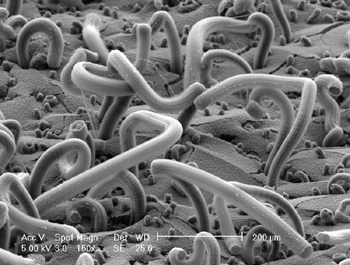This is an image of carbon nanotube (CNT) structures grown by chemical vapor deposition on a silicon substrate, by John Hart, a post-doctoral associate at MIT. At first, a uniform film of CNTs - like grass growing from a field of seeds - sprouted upward from a substrate. Later, some of the CNTs arranged into groups, which grew more rapidly than their neighbors. These groups of CNTs were then constrained by a second substrate, a "cap" which is spaced above the growth substrate. The groups bent and changed direction when they ran into the cap, to give the disordered structures shown in the image. The worm-like structures in "disorder" are approximately 50 micrometers in diameter, which is just less than the width of a typical human hair.
The image was taken using a scanning electron microscope.
Many such images, which are displayed at www.nanobliss.com, resemble everyday objects and macroscopic landscapes; however, these structures are formed by self-assembly interactions at much smaller scales.
So far, most of these images have arisen as results of normal experiments, but in some cases John took a bit more time to image the sample in the microscope, or to refine or add color to the image afterwards. John says he's still very much a scientist, but is seeing now how artistic endeavors can enhance the presentation and visualization of science, and how laboratory techniques such as fabrication and self-assembly can be a new art form.
Courtesy of and Copyright © Anastasios John Hart. Permission to reprint required.
To learn more, visit John's website and his research page
Look for the series at the Nanotechnology Now Gallery soon.
The image was taken using a scanning electron microscope.
Many such images, which are displayed at www.nanobliss.com, resemble everyday objects and macroscopic landscapes; however, these structures are formed by self-assembly interactions at much smaller scales.
So far, most of these images have arisen as results of normal experiments, but in some cases John took a bit more time to image the sample in the microscope, or to refine or add color to the image afterwards. John says he's still very much a scientist, but is seeing now how artistic endeavors can enhance the presentation and visualization of science, and how laboratory techniques such as fabrication and self-assembly can be a new art form.
Courtesy of and Copyright © Anastasios John Hart. Permission to reprint required.
To learn more, visit John's website and his research page
Look for the series at the Nanotechnology Now Gallery soon.











No comments:
Post a Comment